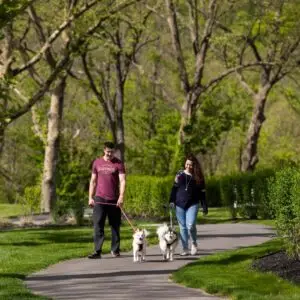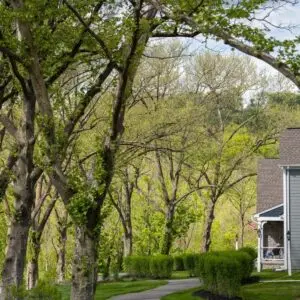There’s nothing quite like a neighborhood with tree-lined roads. Not only are trees beautiful, they’re practical. They provide shade in the summer and, when their leaves drop in the fall, they allow more light in the winter. They also help with biodiversity, providing habitats for the local fauna. Sycamore seeds are eaten by birds like Purple Finches, Goldfinches, Chickadees, and Dark-Eyed Juncos, and the trees themselves can provide nesting sites for birds like the Barred Owl, Eastern Screech-Owl, and the Wood Duck. There have even been studies that show that trees encourage healthier lifestyles and can induce a sense of calm and wellbeing.
When ground was first broken for the Hastings neighborhood, Charter’s Founder Rob Bowman said they found the remnants of a small drive that had been lined by a row of very old sycamore trees. “We did a little bit of research and found that behind those sycamore trees there had been a series of homes,” Bowman says, “so we recreated that whole idea and built homes that look through the trees and onto what is now called Sycamore Lane.”
The tract of land on which the Hastings neighborhood now sits was once owned by the vaunted Carnegie Steel Company in the early 19th century. A little later, the Mayview State Hospital was built there, along with a 900-acre farm on the hillsides above the valley where the campus stood. It produced, raised, and canned everything the campus would need, including pigs, chickens, cows, and produce such as corn, wheat, tomatoes, carrots, and more.
The row of sycamore trees that line Sycamore Lane are the only remnants of the history of the site. “We were able to protect those trees and ensure that they became a part of the Hastings neighborhood,” Bowman says. “You can go buy a tree at a garden center for 20 to 30 bucks, but to have a whole row of pre-existing sycamore trees is priceless.” Though sycamore wood has historically been prized for industrial uses, such as making butcher’s blocks, crates, and other types of boxes, the trees along Sycamore Lane will be a permanent haven for Hastings residents thanks to their wide-canopied, open crown of huge, bending branches.
“It’s one thing to live in a new home,” Bowman says, “but it’s another thing to live in a new home and then have a row of stately trees in front of you on Sycamore Lane. It really is the best of old and new.”


